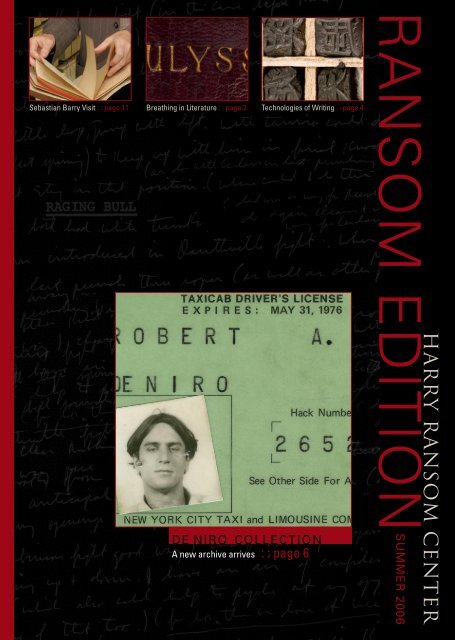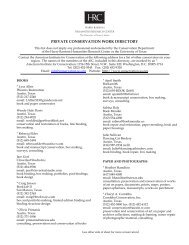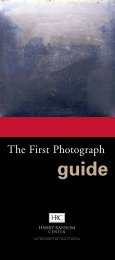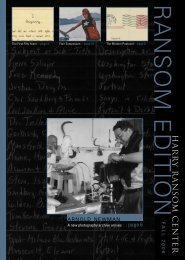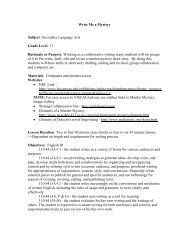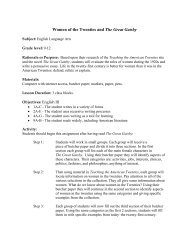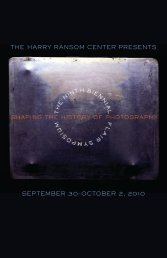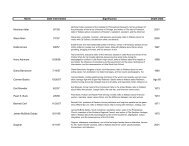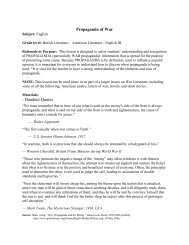Download PDF Version - Harry Ransom Center - The University of ...
Download PDF Version - Harry Ransom Center - The University of ...
Download PDF Version - Harry Ransom Center - The University of ...
You also want an ePaper? Increase the reach of your titles
YUMPU automatically turns print PDFs into web optimized ePapers that Google loves.
Sebastian Barry Visit : : page 11<br />
Breathing in Literature : : page 2<br />
Technologies <strong>of</strong> Writing : : page 4<br />
de niro collection<br />
A new archive arrives : : page 6<br />
RANSOM EDITION<br />
Summer 2006<br />
<strong>Harry</strong> <strong>Ransom</strong> <strong>Center</strong>
RANSOM EDITION<br />
Volume 13 : : Issue 2<br />
Summer 2006<br />
RANSOM EDITION is published<br />
biannually for members and friends<br />
<strong>of</strong> the <strong>Harry</strong> <strong>Ransom</strong> <strong>Center</strong> at<br />
<strong>The</strong> <strong>University</strong> <strong>of</strong> Texas at Austin.<br />
To change your contact information,<br />
please notify:<br />
Alicia Dietrich, Editor<br />
<strong>Ransom</strong> Edition<br />
<strong>Harry</strong> <strong>Ransom</strong> <strong>Center</strong><br />
<strong>The</strong> <strong>University</strong> <strong>of</strong> Texas at Austin<br />
P.O. Box 7219<br />
Austin, TX 78713<br />
aliciadietrich@mail.utexas.edu<br />
HOURS<br />
<strong>Ransom</strong> <strong>Center</strong> Galleries<br />
Tuesday, Wednesday, Friday<br />
10 a.m. to 5 p.m.<br />
Thursday 10 a.m. to 7 p.m.<br />
Saturday and Sunday noon to 5 p.m.<br />
Library Reading Room and<br />
Visual Materials Viewing Room<br />
Monday–Friday 9 a.m. to 5 p.m.<br />
Saturday 9 a.m. to noon<br />
(No Saturday hours for visual<br />
materials viewing)<br />
Phone: 512-471-8944<br />
Fax: 512-471-9646<br />
http://www.hrc.utexas.edu<br />
To stay informed about the latest<br />
happenings at the <strong>Ransom</strong> <strong>Center</strong>,<br />
sign up for eUpdates at<br />
http://www.hrc.utexas.edu/eupdates.<br />
Alicia Dietrich Editor<br />
Anne-Charlotte Patterson Designer<br />
Leslie Ernst Art Direction<br />
Daniel Zmud Webmaster<br />
Unless otherwise noted, photography<br />
by Pete Smith or Eric Beggs.<br />
Cover photo: Detail <strong>of</strong> hack license<br />
used in preparation for Taxi Driver.<br />
Robert De Niro Collection.<br />
Cover background: Shooting script<br />
from Raging Bull.<br />
Robert De Niro Collection.<br />
<strong>The</strong> publishers have made every effort to<br />
contact all copyright holders for permissions.<br />
Those we have been unable to reach are<br />
invited to contact us so that a full<br />
acknowledgment may be given.<br />
© 2006 <strong>Harry</strong> <strong>Ransom</strong> <strong>Center</strong>.<br />
All rights reserved.<br />
This spring the <strong>Ransom</strong> <strong>Center</strong> announced its acquisition <strong>of</strong> the remarkable archive <strong>of</strong> actor<br />
Robert De Niro. A gift from De Niro, the collection includes not only annotated scripts,<br />
notes, research materials, and video and audio recordings, but also an extensive collection<br />
<strong>of</strong> the costumes he wore.<br />
It is an important collection in our cultural history. De Niro appeared in key<br />
films <strong>of</strong> the Hollywood renaissance <strong>of</strong> the 1960s, and his influence and<br />
artistic excellence continue today. De Niro is one <strong>of</strong> the most celebrated<br />
actors in America, and the roles he has portrayed in such iconic films as<br />
Taxi Driver, Raging Bull, and <strong>The</strong> Deer Hunter have become touchstones<br />
<strong>of</strong> our culture.<br />
Through De Niro’s extensive notes and research materials, one can see the<br />
vital creative process—how he transformed words into live action, how<br />
he crossed genres, moving from script to screen. <strong>The</strong> collection will garner<br />
both scholarly and popular interest, but perhaps most exciting for us is the<br />
enthusiasm it has generated on campus, especially among departments<br />
not traditionally associated with our collections. <strong>The</strong> Department <strong>of</strong> Human<br />
Ecology, which has the only graduate program in the region in clothing<br />
conservation, and the Costume Technology program in the Department <strong>of</strong><br />
<strong>The</strong>atre and Dance will be given unprecedented access to the collection<br />
for use in teaching costume design and textile conservation. <strong>The</strong>se<br />
departments will also work with the <strong>Center</strong> on the long-term conservation<br />
needs <strong>of</strong> the costumes. We are pleased to build a partnership with these<br />
departments and strengthen the ties <strong>of</strong> the <strong>Ransom</strong> <strong>Center</strong> to the teaching<br />
mission <strong>of</strong> the <strong>University</strong>. Another key player in this acquisition was<br />
George Mitchell <strong>of</strong> the <strong>University</strong> Co-op, who has generously agreed to<br />
help support the care and conservation <strong>of</strong> the costumes.<br />
<strong>The</strong> acquisition <strong>of</strong> De Niro’s archive enhances a remarkably strong film<br />
collection at the <strong>Ransom</strong> <strong>Center</strong>. His materials will join the archives <strong>of</strong><br />
such film notables as David O. Selznick, Gloria Swanson, Steve Martin, and<br />
Ernest Lehman. De Niro will also support a research fellowship in film, and<br />
he will visit the <strong>Center</strong> in 2007 to celebrate both the acquisition and our<br />
50 th anniversary.<br />
Every summer, friends and members <strong>of</strong> the <strong>Ransom</strong> <strong>Center</strong> ask me for book<br />
recommendations as they put together their summer reading lists. I read<br />
less contemporary fiction than I once did, but many <strong>of</strong> our staff members follow current<br />
literature closely. With this newsletter, we begin a new column that will feature<br />
recommendations <strong>of</strong> contemporary works. Happy reading.<br />
Thomas F. Staley,<br />
Director, <strong>Harry</strong> <strong>Ransom</strong> <strong>Center</strong><br />
Director’s note
denotes a link to<br />
additional materials on the<br />
<strong>Ransom</strong> <strong>Center</strong>’s website<br />
CONTENTS<br />
6<br />
De<br />
Niro<br />
Archive<br />
<strong>Ransom</strong> <strong>Center</strong><br />
acquires Robert<br />
De Niro archive<br />
<strong>The</strong> Sweet Smell<br />
<strong>of</strong> Provenance 2<br />
Fleur Cowles<br />
Flair Symposium<br />
registration is open 3<br />
5<br />
Recommended<br />
Reading<br />
Staff present their<br />
summer reading picks<br />
In the Galleries : :<br />
Technologies <strong>of</strong> Writing<br />
and <strong>The</strong> Image Wrought:<br />
Historical Photographic<br />
Approaches in<br />
the Digital Age 4<br />
Research at the<br />
<strong>Ransom</strong> <strong>Center</strong> : :<br />
“Miss Universe, Mr. Uris,<br />
and <strong>The</strong> Archive” 8<br />
10<br />
Fathoms From<br />
Anywhere<br />
Online exhibition<br />
celebrates centennial<br />
<strong>of</strong> Samuel Beckett<br />
Calendar<br />
Events and upcoming<br />
13exhibitions<br />
Molly Schwartzburg : :<br />
new Curator <strong>of</strong> British<br />
and American Literature 9<br />
In Memoriam : :<br />
Carlton Lake 10<br />
Et Ceterata 12<br />
<strong>Ransom</strong> Edition : :
<strong>The</strong> Sweet Smell <strong>of</strong> Provenance<br />
by Rich Oram and Edward L. Bishop<br />
A characteristic item found in libraries’ special<br />
collections is the so-called association copy, a book whose<br />
significance derives from its connection with a well-known writer,<br />
artist, or historical figure. <strong>The</strong> <strong>Harry</strong> <strong>Ransom</strong> <strong>Center</strong> at <strong>The</strong> <strong>University</strong><br />
<strong>of</strong> Texas at Austin is legendary for owning no fewer than 34 <strong>of</strong> the<br />
1,000 copies <strong>of</strong> the first edition <strong>of</strong> James Joyce’s Ulysses, many<br />
<strong>of</strong> which are association copies.<br />
One copy—which used to belong to T. E. Lawrence, better known as<br />
Lawrence <strong>of</strong> Arabia—stands out for its full range <strong>of</strong> appeals to the<br />
senses. <strong>The</strong> volume has been rebound in sumptuous wine-red leather<br />
ornamented with gilt, and it gives every indication <strong>of</strong> frequent use,<br />
including a well-rubbed binding. Inside, on more than 150 pages, are<br />
pencil annotations about the Dublin landmarks in Joyce’s masterpiece,<br />
as well as more than a few black smudges and even a couple<br />
<strong>of</strong> biscuit crumbs.<br />
In addition, Lawrence’s copy <strong>of</strong> Ulysses is remarkable for its smell.<br />
<strong>The</strong> book has been shown to many visitors and students over the<br />
years. When it is carefully removed from the shelf and ceremoniously<br />
divested <strong>of</strong> its acid-free box, which helps preserve the volume, even<br />
from several inches away you can smell a sweet, somewhat smoky<br />
aroma that suffuses every bit <strong>of</strong> paper and leather. Many people<br />
assume it must be the residue <strong>of</strong> pipe tobacco, perhaps the fruitscented<br />
variety. <strong>The</strong> aroma is a spur to the imagination, summoning<br />
up romantic visions <strong>of</strong> Lawrence by his fireside, puffing reflectively on<br />
a meerschaum, immersed in the drama <strong>of</strong> Leopold Bloom.<br />
<strong>The</strong> aroma made its way into the pages <strong>of</strong> Nicholas A. Basbanes’s<br />
A Splendor <strong>of</strong> Letters: <strong>The</strong> Permanence <strong>of</strong> Books in an<br />
Impermanent World (HarperCollins, 2003), which looks at why<br />
libraries preserve the items they do. Basbanes noted that the <strong>Ransom</strong><br />
<strong>Center</strong> has collected so many copies <strong>of</strong> Ulysses in part because<br />
<strong>of</strong> their associations. Not surprisingly, he focused on the singularly<br />
sensual Lawrence copy and the “tobacco” scent.<br />
Basbanes’s reference to Lawrence’s pipe was piquant enough to draw<br />
the attention <strong>of</strong> a book reviewer in the Times Literary Supplement. A<br />
Lawrence devotee spotted the review and wrote a letter to the Times<br />
saying that the scent could not be tobacco because Lawrence never<br />
smoked a pipe (Ed Maggs, a London rare-books dealer and Lawrence<br />
admirer, had earlier made the same point during a visit to the <strong>Ransom</strong><br />
<strong>Center</strong>). Another correspondent had a theory that the smell was ink.<br />
Sniffing a literary controversy in the making, one <strong>of</strong> us—<br />
Richard Oram—decided to have the copy examined scientifically.<br />
State-<strong>of</strong>-the-art tests by a company specializing in the analysis <strong>of</strong><br />
commercial scents would have been costly and time-consuming.<br />
Some books in the <strong>Ransom</strong> <strong>Center</strong>’s collections tell a story just by their smells.<br />
This copy <strong>of</strong> Ulysses, which belonged to T. E. Lawrence, has a sweet, smoky<br />
scent that reveals much about the book’s history and its handlers.<br />
<strong>The</strong> more practical alternative was to test the aroma on eight <strong>of</strong> the<br />
<strong>Center</strong>’s conservators, whose highly trained noses are so acute that<br />
they could detect the differences between strains <strong>of</strong> molds. <strong>The</strong> verdict<br />
was split: Some <strong>of</strong> the eight thought they smelled deteriorated leather;<br />
others voted for ashes, pipe smoke, the exhaust from Lawrence’s famous<br />
motorbike, and even licorice.<br />
As so <strong>of</strong>ten happens in special-collections libraries, a hallway conversation<br />
between a curator and a scholar—the authors <strong>of</strong> this essay—uncovered<br />
the solution. Edward Bishop’s research on the Lawrence copy,<br />
which had been published in the 1998 Joyce Studies Annual, revealed<br />
that the marginalia in the volume were not in Lawrence’s hand. Mainly<br />
factual notes to do with Dublin, they were by his friend W. M. M. Hurley<br />
and may have been written for Lawrence, who had trouble getting<br />
through the book.<br />
<strong>Ransom</strong> Edition : :
Recent Acquisitions<br />
Lawrence once complained to the painter Eric Kennington, “Arnold Bennett...<br />
said the perfect word about Ulysses, when he swore that Joyce had<br />
made novel-reading a form <strong>of</strong> penal servitude... Such dull stuff... It goes<br />
on for ever.”<br />
While stationed at the Royal Air Force base in Karachi, Pakistan, Lawrence<br />
lent books to the “book-hungry men.” He wrote to George Bernard Shaw’s<br />
wife, Charlotte: “We are rough, and dirty handed, so that some <strong>of</strong> the volumes<br />
are nearly read to death. You can tell the pet ones, by their<br />
shabbiness.” <strong>The</strong> crumbs and stains in Lawrence’s Ulysses testify to<br />
servicemen’s reading the book on their breaks with a mug <strong>of</strong> tea and a biscuit.<br />
Or perhaps a pipe.<br />
In another case <strong>of</strong> olfactory scholarship, John Seely Brown and Paul Duguid,<br />
authors <strong>of</strong> <strong>The</strong> Social Life <strong>of</strong> Information (Harvard Business School Press,<br />
2000), refer to the medical historian who was seen sniffing eighteenthcentury<br />
papers in a Portuguese archive. He could determine how far a cholera<br />
outbreak had traveled by detecting the telltale smell <strong>of</strong> vinegar used as a<br />
disinfectant, which was still attached to the paper after more than two<br />
centuries. As Brown and Duguid observe, scent cannot be conveyed in any<br />
digitized form (at least until a digital scratch-and-sniff is invented).<br />
Librarians and archivists have long known that the mysterious spoor <strong>of</strong><br />
provenance—the fascination provoked by the famous people who once<br />
owned objects like books, manuscripts, and clothes—enthralls both<br />
pr<strong>of</strong>essional scholars and casual visitors to exhibitions. An object connected<br />
to a celebrity provides a frisson, a sense <strong>of</strong> contact with the past and with<br />
the famous person.<br />
<strong>The</strong> encounter with the Lawrence Ulysses had convinced Bishop—who<br />
was then in the early stages <strong>of</strong> writing Riding With Rilke: Reflections on<br />
Motorcycles and Books (Viking Canada, 2005)—that working in an archive<br />
is like riding a motorcycle: You read the topography <strong>of</strong> the texts as well as<br />
the linguistic codes; you get a perceptual jolt as well as an intellectual thrill.<br />
Responding to handwriting, looking at the stamps on letters, feeling and<br />
sniffing paper, hearing the flap <strong>of</strong> heavy parchment pages, you read with all<br />
your senses.<br />
Lawrence’s sweet-smelling Ulysses is unusually evocative because it<br />
“speaks” to the human sense most closely associated with memory. That<br />
association copy is truly associative, relating a story not only about Lawrence,<br />
as it turns out, but about other readers as well. Although the olfactory element<br />
is rare, most books in special collections have their tales to tell, their<br />
sweet smell <strong>of</strong> provenance. Without denying the considerable research value<br />
<strong>of</strong> digital surrogates, we maintain that only preserving original artifacts can<br />
ensure that future readers will be able to share the same sensory experience.<br />
Richard W. Oram is Associate Director and Hobby Foundation Librarian<br />
at the <strong>Ransom</strong> <strong>Center</strong>. Edward L. Bishop is a Pr<strong>of</strong>essor <strong>of</strong> English at the<br />
<strong>University</strong> <strong>of</strong> Alberta. This article originally appeared in the Chronicle <strong>of</strong><br />
Higher Education on September 30, 2005.<br />
: : <strong>The</strong> complete archive <strong>of</strong> actor Robert De Niro,<br />
including annotated film scripts, research<br />
materials and notes, correspondence, video and<br />
audio recordings, photographs, and costumes<br />
: : <strong>The</strong> papers <strong>of</strong> British writer and playwright<br />
Simon Gray<br />
: : An extensive collection <strong>of</strong> books by detective novelist<br />
John D. MacDonald<br />
: : <strong>The</strong> archive <strong>of</strong> Fiction Collective writer Steve Katz<br />
: : A collection <strong>of</strong> letters by American writer<br />
James Salter<br />
: : Scores and choreographic notes used to stage the<br />
first ballet performance <strong>of</strong> David Guion’s “Shingandi”<br />
: : <strong>The</strong> papers <strong>of</strong> bibliographers William B. Todd and<br />
Ann Bowden, related to their publishing projects and<br />
work at the <strong>Ransom</strong> <strong>Center</strong><br />
: : Additional materials for the archives <strong>of</strong> Sebastian<br />
Barry, Sybille Bedford, Sanora Babb, Christine<br />
Brooke-Rose, Shelby Hearon, Bernard Kops,<br />
Penelope Lively, and the Peter Owen<br />
publishing firm<br />
2006 Fleur Cowles<br />
Flair Symposium<br />
Registration is now open for the 2006 Fleur Cowles<br />
Flair Symposium, <strong>The</strong> Sense <strong>of</strong> Our Time: Norman<br />
Mailer and America in Conflict. <strong>The</strong> symposium will<br />
take place November 9–11, 2006.<br />
Speakers at the symposium will use Mailer’s works as<br />
starting points for the exploration <strong>of</strong> the cultural conflicts<br />
that confronted post-WWII America, from civil<br />
rights to war, from sexual politics to the rise <strong>of</strong> New<br />
Journalism. Speakers include Pulitzer Prize-winning<br />
author David Oshinsky <strong>of</strong> <strong>The</strong> <strong>University</strong> <strong>of</strong> Texas at<br />
Austin, Sam Tanenhaus <strong>of</strong> the New York Times, Morris<br />
Dickstein <strong>of</strong> the CUNY <strong>Center</strong><br />
for the Humanities, and Norman<br />
Mailer. <strong>The</strong> Flair Symposium,<br />
held biennially at the <strong>Ransom</strong><br />
<strong>Center</strong>, honors the ideals set<br />
forth by Fleur Cowles and her<br />
landmark Flair magazine.<br />
8<br />
For more information, visit<br />
http://www.hrc.utexas.edu/flair,<br />
call 512-471-8944, or<br />
email Robert Fulton at kaspar@mail.utexas.edu<br />
<strong>Ransom</strong> Edition : :
IN THE GALLERIES<br />
In the Galleries: Technologies <strong>of</strong> Writing<br />
<strong>The</strong> <strong>Ransom</strong> <strong>Center</strong>’s current exhibition, Technologies <strong>of</strong><br />
Writing, which runs through August 6, documents the<br />
evolution and history <strong>of</strong> writing.<br />
Writing is perhaps man’s greatest invention. Not even the<br />
development <strong>of</strong> language is comparable, for all species have<br />
a means <strong>of</strong> communication. Writing, though, is what enables<br />
language to be copied and stored. Writing provides us with<br />
a cultural memory, which is in large part what makes us<br />
human.<br />
<strong>The</strong> exhibition, curated by Pr<strong>of</strong>essor Kurt Heinzelman and<br />
graduate student Elizabeth Garver, with assistance from<br />
many other faculty and staff members, showcases rare,<br />
original artifacts dating from 2000 BCE to the present.<br />
Featured items range from cuneiform tablets to electronic<br />
texts, showing that the development <strong>of</strong> writing is ongoing<br />
and responsive to technological innovations.<br />
In the Galleries: <strong>The</strong> Image Wrought<br />
Running though August 6, <strong>The</strong> Image Wrought:<br />
Historical Photographic Approaches in the<br />
Digital Age highlights the work <strong>of</strong> contemporary<br />
photographers who embrace antiquated nineteenth-century<br />
practices.<br />
<strong>The</strong> nearly universal practice <strong>of</strong> digital<br />
photography has motivated some photographers to<br />
revert back to seemingly obsolete processes with<br />
unique and unpredictable outcomes that better<br />
reflect the artist’s touch in the face <strong>of</strong> the pristine<br />
pixel. Curator Linda Briscoe Myers says, “<strong>The</strong><br />
exhibition demonstrates that there is an inherent<br />
tactile beauty to these handcrafted images that<br />
differ from those produced entirely through digital technology.”<br />
Drawn from the <strong>Ransom</strong> <strong>Center</strong>’s extensive photographic collection, the<br />
exhibition <strong>of</strong>fers the unique opportunity to see the contemporary pieces paired<br />
alongside their vintage predecessors, which were produced by the same<br />
processes more than 100 years earlier. <strong>The</strong> pairings create a dialog that<br />
reveals how the modern photographer approaches his or her historical model.<br />
FROM TECHNOLOGIES OF WRITING<br />
Korean type; 18th century<br />
FROM THE IMAGE WROUGHT<br />
Left: Anna Atkins<br />
Specimen <strong>of</strong> Cyanotype - Peacock [feathers], 1845;<br />
Cyanotype<br />
Right: © Jesseca Ferguson<br />
Songs Without Words, 2000;<br />
Pinhole Ware cyanotype, sheet music, book board<br />
<strong>The</strong> exhibition <strong>of</strong>fers nearly 70 examples <strong>of</strong> contemporary and nineteenthcentury<br />
photographs that explore not only historical processes, but also<br />
camera technology, photographs made on alternative supports, and photographs<br />
with surface treatments.<br />
Read <strong>The</strong> Economist’s review <strong>of</strong> the exhibition<br />
8 at http://www.hrc.utexas.edu/ransomedition.<br />
<strong>Ransom</strong> Edition : :
Recommended Reading<br />
Megan Barnard, Assistant to Director Tom Staley, and Jackie Carroll, a librarian and book cataloger at the <strong>Ransom</strong> <strong>Center</strong>, collaborate to<br />
identify up-and-coming talents for the <strong>Ransom</strong> <strong>Center</strong>’s contemporary authors book-collecting program. <strong>The</strong> <strong>Center</strong> collects first editions<br />
<strong>of</strong> writers identified for this program, hoping to build its holdings in the works <strong>of</strong> writers whose reputations will grow with the years. Here<br />
are their recommendations for summer reading.<br />
Cloud Atlas by David Mitchell<br />
(Sceptre, 2004)<br />
This book is a clever puzzle <strong>of</strong> sorts, with Mitchell weaving six<br />
stories and points in time into a single frame. <strong>The</strong> writing is<br />
lush, contemplative, and witty, with plots that keep the pages<br />
turning. It’s an enthralling and impressive work.<br />
Extremely Loud and Incredibly Close<br />
by Jonathan Safran Foer<br />
(Houghton Mifflin, 2005)<br />
<strong>The</strong> second novel <strong>of</strong> this talented writer follows nine-yearold<br />
Oskar Schell on his mission to find the lock that fits a key<br />
belonging to his father, who was killed in the attacks on the<br />
World Trade <strong>Center</strong>. Foer finds some <strong>of</strong> the most devastatingly<br />
beautiful ways to express grief and how people come to terms<br />
with it.<br />
Brick Lane by Monica Ali (Doubleday, 2003)<br />
Spanning approximately 30 years and culminating around 9/11,<br />
this novel looks at the life <strong>of</strong> a young Bengali woman in an<br />
arranged marriage, living in the East London neighborhood <strong>of</strong><br />
Brick Lane. It deals with the larger contemporary issues <strong>of</strong><br />
immigration and acceptance while focusing on the emotional<br />
and physical maturity <strong>of</strong> a young woman.<br />
Also <strong>of</strong> note are the new<br />
books <strong>of</strong> two Texas writers, Stephen<br />
Harrigan’s Challenger Park (Knopf,<br />
2006) and Elizabeth Crook’s<br />
<strong>The</strong> Night Journal (Viking, 2006)<br />
A Long Long Way by Sebastian Barry<br />
(Faber, 2005)<br />
It’s no surprise to learn, after reading this lyrical novel, that<br />
Barry is also a talented poet. He tells a moving story about the<br />
almost-forgotten Irish soldiers <strong>of</strong> World War I who fought in<br />
the British Army while their homeland erupted into a struggle<br />
for independence. He writes with compassion about the fear,<br />
confusion, and mixed loyalties <strong>of</strong> these young Irishmen. Barry’s<br />
archive is housed at the <strong>Ransom</strong> <strong>Center</strong>.<br />
2006 promotional sponsors.<br />
<strong>The</strong> <strong>Ransom</strong> <strong>Center</strong> would like to give special thanks to our 2006 promotional sponsors:<br />
<strong>Ransom</strong> Edition : :
Robert De Niro Donates<br />
Collection <strong>of</strong> Film Materials<br />
to <strong>Harry</strong> <strong>Ransom</strong> <strong>Center</strong><br />
Hack license used in preparation for Taxi Driver (1976).<br />
Robert De Niro Collection. <strong>Harry</strong> <strong>Ransom</strong> <strong>Center</strong>.<br />
Actor, director, producer Robert<br />
DeNiro has donated his complete collection <strong>of</strong><br />
film-related materials to the <strong>Ransom</strong> <strong>Center</strong>.<br />
With materials from the late 1960s to the<br />
present, the archive includes annotated scripts,<br />
notes, research materials, and an extensive collection<br />
<strong>of</strong> the costumes DeNiro wore in his films.<br />
<strong>The</strong> paper portion <strong>of</strong> the collection, more than<br />
100 boxes, has considerable research value.<br />
It includes scripts and books with handwritten<br />
notations, correspondence with film notables<br />
such as Martin Scorsese and Elia Kazan, background<br />
research, and the notebooks DeNiro kept<br />
<strong>of</strong> his films, all showing the evolution from text to<br />
moving image.<br />
<strong>The</strong> costume portion <strong>of</strong> the collection includes<br />
more than 3,000 individual costume items, props<br />
from many <strong>of</strong> DeNiro’s films, and a full body cast<br />
used in the 1994 production <strong>of</strong> Frankenstein.<br />
“One <strong>of</strong> the most important things about the<br />
<strong>Harry</strong> <strong>Ransom</strong> <strong>Center</strong> is that the material will be<br />
accessible to students and the public,”<br />
Shooting Script from <strong>The</strong> Deer Hunter (1978).<br />
Robert De Niro Collection. <strong>Harry</strong> <strong>Ransom</strong> <strong>Center</strong>.<br />
<strong>Ransom</strong> Edition : :
Hat worn by “Johnny Boy” in Mean Streets (1973).<br />
Robert De Niro Collection. <strong>Harry</strong> <strong>Ransom</strong> <strong>Center</strong>.<br />
said DeNiro.<br />
“Ultimately, that’s<br />
what it’s all about.”<br />
<strong>The</strong> DeNiro archive enhances the film collection at the <strong>Ransom</strong> <strong>Center</strong><br />
and adds significantly to the <strong>Center</strong>’s holdings in Hollywood filmmaking<br />
<strong>of</strong> the late 20th century. A fellowship will be established to support<br />
scholarly research in the collection.<br />
“This acquisition broadens opportunities for scholars and students to<br />
study new areas <strong>of</strong> film, such as the actor’s role in authorship,” said<br />
Thomas F. Staley, Director <strong>of</strong> the <strong>Ransom</strong> <strong>Center</strong>.<br />
DeNiro is regarded as one <strong>of</strong> the greatest actors <strong>of</strong> his generation and a<br />
key figure in “<strong>The</strong> New Hollywood,” an artistic renaissance that began<br />
in the late 1960s. He appeared in many <strong>of</strong> the period’s key films:<br />
Taxi Driver (1976), Raging Bull (1980), <strong>The</strong> Godfather: Part II (1974),<br />
and <strong>The</strong> Deer Hunter (1978). DeNiro has produced more than two<br />
dozen films since the late 1980s and directed A Bronx Tale (1993) and<br />
the soon to be released <strong>The</strong> Good Shepherd.<br />
“DeNiro is renowned for the meticulous research he puts into each<br />
role, and all that material is present in the collection: books, manuscripts,<br />
costumes, interviews, photographs, videotapes—everything,”<br />
said Steve Wilson, Associate Curator <strong>of</strong> the <strong>Ransom</strong> <strong>Center</strong>’s film collection.<br />
“<strong>The</strong> collection is awe-inspiring in its depth and scope. I know <strong>of</strong><br />
no other actor’s archive that is as large and comprehensive as this one.”<br />
<strong>The</strong> <strong>University</strong>’s Department <strong>of</strong><br />
Human Ecology in the College <strong>of</strong><br />
Natural Sciences, the Department <strong>of</strong> Radio-<br />
Television-Film in the College <strong>of</strong> Communication, and the<br />
Department <strong>of</strong> <strong>The</strong>atre and Dance in the College <strong>of</strong> Fine Arts<br />
have all expressed excitement about using the collection.<br />
<strong>The</strong> departments <strong>of</strong> Human Ecology and <strong>The</strong>atre and Dance are<br />
especially interested in the costume portion <strong>of</strong> the collection.<br />
Costume selection is an integral part <strong>of</strong> DeNiro’s process <strong>of</strong><br />
character development, and thus the wardrobe component <strong>of</strong> the<br />
archive is remarkably rich.<br />
Fred Heath, Vice Provost and Director <strong>of</strong> <strong>University</strong> <strong>of</strong> Texas<br />
Libraries, <strong>of</strong>fered assistance with the housing <strong>of</strong> the costume<br />
portion <strong>of</strong> the collection.<br />
Another key figure in this acquisition is George Mitchell, President<br />
<strong>of</strong> <strong>University</strong> Co-op. Mitchell has agreed to support the preservation<br />
and housing <strong>of</strong> the costumes and display some <strong>of</strong> the collection<br />
materials in the Co-op’s gallery. Mitchell and the Co-op’s support <strong>of</strong><br />
the <strong>Ransom</strong> <strong>Center</strong> has funded acquisitions, exhibitions,<br />
and lectures.<br />
Select items from the DeNiro collection were on view in the<br />
<strong>Ransom</strong> <strong>Center</strong>’s lobby in June. Once processed, cataloged, and<br />
housed, the collection will be available for research.<br />
Makeup photo<br />
for Godfather II<br />
(1974).<br />
Robert De Niro<br />
Collection.<br />
<strong>Harry</strong> <strong>Ransom</strong><br />
<strong>Center</strong>.<br />
Shooting Script<br />
from Raging Bull<br />
(1980).<br />
Robert De Niro<br />
Collection.<br />
<strong>Harry</strong> <strong>Ransom</strong><br />
<strong>Center</strong>.<br />
<strong>Ransom</strong> Edition : :
Research at the <strong>Ransom</strong> <strong>Center</strong>:<br />
Miss Universe, Mr. Uris,<br />
and <strong>The</strong> Archive<br />
by Ira B. Nadel<br />
Miss Universe and Leon Uris seem at first an unusual<br />
couple. But from research in the Uris archive at the <strong>Ransom</strong> <strong>Center</strong>,<br />
the unexpected connection is clear.<br />
As one <strong>of</strong> America’s most popular writers from 1953 until his death in<br />
2003, Uris received numerous honors, awards, and praise, although<br />
he liked to introduce himself as a “12-time Pulitzer Prize loser.”<br />
Nevertheless, in pursuing details <strong>of</strong> this remarkable writer’s life for<br />
a forthcoming biography, I came across an unusual set <strong>of</strong> items in<br />
his scrapbooks: airline tickets, passports, hotel receipts, press clippings,<br />
and the program for the 1975 Miss Universe contest held in El<br />
Salvador. Uris was a judge, joining Peter Lawford, Susan Strasberg,<br />
Sarah Vaughan, Ernest Borgnine, and Olympic skier Jean-Claude Killy.<br />
Background sheets on each <strong>of</strong> the twelve finalists accompany a copy<br />
<strong>of</strong> Uris’s itinerary and program for the final judging. It was to take<br />
place in the redecorated National Gymnasium <strong>of</strong> El Salvador, transformed<br />
into a gigantic Mayan pyramid. Scrapbook photos show the<br />
judges—Uris in a white tuxedo with frill shirt—hard at work jotting<br />
down comments and responses before selecting Miss Finland, Anne<br />
Marie Pohtamo, as the winner.<br />
Uris’s autographed program from the event contains amusing remarks<br />
from his fellow judges: the actress Susan Strasberg wrote “If I only<br />
had a larger social conscience.” <strong>The</strong> journalist Max Lerner <strong>of</strong>fered<br />
“To Jill and Leon—beauty and the beast—each <strong>of</strong> you with great<br />
powers,” while the skier Jean-Claude Killy exclaimed “from one skier<br />
& great one to another skier & better one!” Such colorful remarks are<br />
irresistible in an account <strong>of</strong> the novelist’s life.<br />
<strong>The</strong> Miss Universe contest is only one <strong>of</strong> numerous discoveries in the<br />
Uris archive, which first arrived at the <strong>Ransom</strong> <strong>Center</strong> in 1997. Among<br />
the more interesting items included is an outline and research notes<br />
for an unwritten novel about immigrants in the lower East Side <strong>of</strong><br />
New York and a completed but unpublished children’s story entitled<br />
“Secrets <strong>of</strong> Forever Island.“ Vivid letters written to his stepsister and<br />
parents during his Marine Corps training in 1942—Uris dropped out<br />
<strong>of</strong> high school to enlist only weeks after Pearl Harbor—reveal details<br />
<strong>of</strong> his military life, which provided source material for his first novel,<br />
Battle Cry. Other discoveries include criticism from the Israeli<br />
Foreign Office <strong>of</strong> errors in an early draft <strong>of</strong> Exodus, the actual transcript<br />
<strong>of</strong> his 1964 English libel case, which he would turn into QBVII,<br />
and a copy <strong>of</strong> his first fan letter. An added bonus are hundreds <strong>of</strong><br />
photographs he took as part <strong>of</strong> his research for novels Exodus<br />
and Trinity.<br />
Secondary material can provide additional insight about a subject,<br />
and for Uris one <strong>of</strong> the most interesting early events in his career was<br />
the world premier <strong>of</strong> the 1955 movie Battle Cry. Press accounts <strong>of</strong><br />
<strong>Ransom</strong> Edition : : <br />
Ira B. Nadel, Pr<strong>of</strong>essor <strong>of</strong> English at the <strong>University</strong> <strong>of</strong> British Columbia<br />
and research fellow at the <strong>Ransom</strong> <strong>Center</strong>, works with materials from<br />
the Leon Uris archive in the reading room.<br />
the gala in Baltimore, Uris’s home town, detail the support <strong>of</strong> the entire<br />
city. A wonderful letter by Uris’s wife, Betty, to her parents with her<br />
impression <strong>of</strong> the event supplements the public record. <strong>The</strong> presence <strong>of</strong><br />
movie stars Dorothy Malone, Mona Freeman, the director Raoul Walsh,<br />
plus the young heartthrob Tab Hunter, meant a sellout <strong>of</strong> the 2,800-seat<br />
Stanley <strong>The</strong>atre. Uris stayed on, but the stars left for the opening the<br />
next day in New York. Capitalizing on his skyrocketing appeal, Warner<br />
Bros. had Tab Hunter appear at the 8:30 a.m. show to hand out pairs <strong>of</strong><br />
nylons to the first 100 female guests.<br />
<strong>The</strong> archive charts Uris’s development as a writer from juvenile efforts<br />
as a dramatist to his detailed research for his massive novel about<br />
Ireland, Trinity. His travel for novels like Mila 18 and Armageddon<br />
are thoroughly documented, as are his unsuccessful attempts to bring<br />
Exodus to the stage as the musical Ari and efforts to write filmscripts<br />
for his major novels. Further riches include the record <strong>of</strong> his philanthropic<br />
activities and correspondence with his readers. Asked to name<br />
the most influential books in his life, he cites the work <strong>of</strong> Steinbeck.<br />
Asked when he planned to take up golf, he responds, “after my first<br />
heart attack.” Asked his favorite passage from his own work, he<br />
replies, “the end.”<br />
From such disparate material, the personality <strong>of</strong> the writer emerges.<br />
Access to such material is invaluable, and biographers can never<br />
have enough <strong>of</strong> it.<br />
Ira B. Nadel, Pr<strong>of</strong>essor <strong>of</strong> English at the <strong>University</strong> <strong>of</strong> British Columbia and<br />
frequent visitor to the <strong>Ransom</strong> <strong>Center</strong>’s archives, is the author <strong>of</strong> biographies<br />
<strong>of</strong> Leonard Cohen, Tom Stoppard, and Ezra Pound. A Dorot Fellowship<br />
supported his work at the <strong>Ransom</strong> <strong>Center</strong>.<br />
<br />
8<br />
Learn more about the Leon Uris archive at<br />
http://www.hrc.utexas.edu/ransomedition.
Molly Schwartzburg joins <strong>Ransom</strong> <strong>Center</strong><br />
as Curator <strong>of</strong> British and American Literature<br />
<strong>The</strong> <strong>Ransom</strong> <strong>Center</strong><br />
announces the appointment<br />
<strong>of</strong> Dr. Molly Schwartzburg as<br />
Curator <strong>of</strong> British and<br />
American Literature.<br />
Schwartzburg arrives at<br />
the <strong>Center</strong> after teaching in<br />
the Program in Structured<br />
Liberal Education at Stanford<br />
<strong>University</strong> as a Post-Doctoral<br />
Fellow. <strong>The</strong> program allows<br />
both pr<strong>of</strong>essors and students to embrace multiple disciplines, such as<br />
political science, literature, and philosophy, while exploring great books <strong>of</strong><br />
civilization chronologically.<br />
She earned her Ph.D. in English and American Literature from Stanford<br />
in 2004, with a specialization in modern and contemporary poetry and<br />
the avant-garde. She worked as an archivist at Stanford and earlier as an<br />
assistant in preservation at the <strong>University</strong> <strong>of</strong> Colorado at Boulder, where<br />
she earned her M.A degree.<br />
Throughout her career, Schwartzburg has embraced an interdisciplinary<br />
approach that explores both literature and the visual arts. In her research<br />
on contemporary artists’ books, works that blend together art and the<br />
written word, questions <strong>of</strong>ten arise over where such works belong. But<br />
the <strong>Ransom</strong> <strong>Center</strong> helps solve that dilemma for her.<br />
“<strong>The</strong> best thing about the <strong>Ransom</strong> <strong>Center</strong> is that it lies somewhere between<br />
a library and a museum,” says Schwartzburg. “Institutional barriers<br />
are dissolved here between literature and visual art, allowing audiences<br />
to think comparatively.”<br />
Schwartzburg replaces John Kirkpatrick, who served as the <strong>Ransom</strong><br />
<strong>Center</strong>’s Curator <strong>of</strong> British and American Literature for almost 35 years<br />
before retiring in 2005.<br />
<strong>Ransom</strong> <strong>Center</strong> Receives Design Awards<br />
<strong>The</strong> <strong>Harry</strong> <strong>Ransom</strong> <strong>Center</strong> received two design awards in the 2006<br />
American Association <strong>of</strong> Museums national Museum Publication<br />
Design Competition.<br />
<strong>The</strong> <strong>Ransom</strong> <strong>Center</strong> was the only Texas institution to earn a first-place<br />
award, for its poster design for the exhibition Technologies <strong>of</strong> Writing.<br />
<strong>The</strong> <strong>Center</strong> also earned honorable mention for its fall 2005 and spring<br />
2006 program calendars. Leslie Ernst, graphic designer with the<br />
<strong>University</strong>’s Office <strong>of</strong> Public Affairs, created the winning designs.<br />
Judged by museum pr<strong>of</strong>essionals, publishers, and designers, the<br />
competition recognizes excellence in overall design.<br />
<strong>The</strong> <strong>Ransom</strong> <strong>Center</strong>’s program calendar was also chosen by the American<br />
Library Association as Best in Show in the “Calendars & Newsletters”<br />
category from more than 360 entries.<br />
Stella Adler and the<br />
American <strong>The</strong>ater<br />
<strong>The</strong> <strong>Ransom</strong> <strong>Center</strong>, the College <strong>of</strong> Fine Arts, the College<br />
<strong>of</strong> Communication, the Austin Film Society, and the Austin<br />
Circle <strong>of</strong> <strong>The</strong>aters collaborated in the spring to present<br />
“Stella Adler and the American <strong>The</strong>ater,” a series <strong>of</strong> public<br />
programs celebrating legendary acting teacher Stella Adler.<br />
<strong>The</strong> programs were part <strong>of</strong> the <strong>Ransom</strong> <strong>Center</strong>’s<br />
“Signatures Series,” a series <strong>of</strong> events that highlight the<br />
<strong>Center</strong>’s recent archival acquisitions. <strong>The</strong> <strong>Ransom</strong> <strong>Center</strong><br />
acquired Adler’s archive in 2004. <strong>The</strong> programs culminated<br />
with a visit by filmmaker and former Adler student Peter<br />
Bogdanovich, who spoke about his work and Adler at a<br />
screening <strong>of</strong> his Academy Award-winning film <strong>The</strong> Last<br />
Picture Show (1971).<br />
Former Stella Adler student Peter Bogdanovich talks with <strong>Ransom</strong><br />
<strong>Center</strong> Director Thomas F. Staley before the <strong>Ransom</strong> <strong>Center</strong>’s<br />
screening <strong>of</strong> <strong>The</strong> Last Picture Show.<br />
<strong>The</strong> Alamo Drafthouse Downtown screened films<br />
starring Adler’s students in a series titled “Method Acting<br />
Masterpieces: <strong>The</strong> Adler School.” Films included On the<br />
Waterfront (1954), Bonnie and Clyde (1967), and<br />
Taxi Driver (1976).<br />
To learn more about the Stella Adler archive, visit<br />
8 http://www.hrc.utexas.edu/ransomedition.<br />
Fellowships<br />
<strong>The</strong> <strong>Ransom</strong> <strong>Center</strong> awarded 42 fellowships as part <strong>of</strong> its<br />
2006–2007 research fellowship program. Visit our website<br />
for the complete list <strong>of</strong> recipients and their research topics,<br />
ranging from seventeenth- and eighteenth-century British<br />
piracy in the Americas to the legal life <strong>of</strong> Oscar Wilde.<br />
8 http://www.hrc.utexas.edu/ransomedition<br />
<strong>Ransom</strong> Edition : :
In Memoriam: Carlton Lake<br />
Carlton Lake, whose exceptional collection <strong>of</strong> modern French materials forms<br />
the basis <strong>of</strong> the <strong>Harry</strong> <strong>Ransom</strong> <strong>Center</strong>’s French collection, died May 5, 2006, after a long battle with<br />
Parkinson’s disease. He was 90.<br />
Lake and his collection first came to the attention <strong>of</strong> <strong>Harry</strong> <strong>Ransom</strong> in the late 1960s, and by the<br />
end <strong>of</strong> 1968, a large portion <strong>of</strong> what is now the Carlton Lake collection was making its way to<br />
<strong>The</strong> <strong>University</strong> <strong>of</strong> Texas at Austin from Paris and Boston—the two places Lake called home. In 1969<br />
<strong>Ransom</strong> brought Lake aboard as a consultant and <strong>of</strong>fered him the position <strong>of</strong> “lifetime curator.” While<br />
he considered the <strong>of</strong>fer, Lake worked on the Baudelaire to Beckett exhibition, one <strong>of</strong> the <strong>Center</strong>’s first<br />
blockbuster shows, mounted in 1976, which put Austin on the map as the leading institution outside<br />
France for the study <strong>of</strong> French Modernism. In that same year, Lake accepted appointment as Curator <strong>of</strong><br />
the <strong>Center</strong>’s French collection.<br />
Lake came to his new role not only as an active collector but also as an accomplished writer, having<br />
served as an art critic in Paris for <strong>The</strong> Christian Science Monitor and author <strong>of</strong> articles, stories, essays,<br />
and extended interviews (with Picasso, Matisse, Chagall, Henry Moore, Giacometti, and others) in <strong>The</strong><br />
Atlantic Monthly, <strong>The</strong> New Yorker, <strong>The</strong> New York Times, and other American and European periodicals.<br />
Among his book publications are A Dictionary <strong>of</strong> Modern Painting, In Quest <strong>of</strong> Dali, Life With<br />
Picasso (co-authored with Françoise Gilot), and Confessions <strong>of</strong> a Literary Archeologist.<br />
Carlton Lake with the first edition <strong>of</strong><br />
Alfred Jarry’s Léda, 1981.<br />
<strong>The</strong> original manuscript (1899–1900) <strong>of</strong><br />
this one-act opérette-bouffe is in the<br />
Lake collection, but the book was not<br />
published until 1981. Lake was associated<br />
with the <strong>Ransom</strong> <strong>Center</strong> for almost<br />
35 years before his retirement in 2003.<br />
In his 34-year association with the <strong>Ransom</strong> <strong>Center</strong>, Carlton Lake served as Curator <strong>of</strong> the French<br />
Unidentified photographer<br />
collection, Acting Director (1978–1980), and Executive Curator (1980–2003). He continued to make gifts to the collection and was responsible for<br />
bringing to the <strong>Center</strong> major holdings, such as the Edward Weeks Atlantic Monthly papers, Anne Sexton’s archive, Ezra Pound’s library, Robert<br />
Lowell’s papers, Nina Matheson’s Vladimir Nabokov collection, many Beckett correspondences, Maurice Saillet’s James Joyce and Alfred Jarry<br />
collections, Edouard Dujardin’s archive, Edgard Varése’s library, and the Durand modern-music manuscript collection.<br />
<strong>The</strong> <strong>Ransom</strong> <strong>Center</strong>’s current online exhibition, Fathoms from Anywhere: A Samuel Beckett Centenary Exhibition, is dedicated to Lake.<br />
A memorial service for Carlton Lake was held on May 24 at the <strong>Ransom</strong> <strong>Center</strong>.<br />
Web exhibition celebrates centennial <strong>of</strong> Samuel Beckett<br />
<strong>The</strong> <strong>Ransom</strong> <strong>Center</strong> introduced an online exhibition, Fathoms From<br />
Anywhere: A Samuel Beckett Centenary Exhibition, on April 13 to celebrate the<br />
centennial <strong>of</strong> the birth <strong>of</strong> Nobel Prize-winning writer Samuel Beckett (1906–1989).<br />
<strong>The</strong> web exhibition traces Beckett’s career, using materials from the <strong>Ransom</strong> <strong>Center</strong>’s<br />
collection. Exhibition highlights include a textual and pictorial overview <strong>of</strong> Beckett’s career,<br />
brief biographies <strong>of</strong> his contemporaries and friends, and the opportunity for web visitors<br />
to share their views on Beckett and his works.<br />
“<strong>The</strong> online exhibition should be a destination not only for Beckett scholars, but for anyone<br />
who wants to learn more about one <strong>of</strong> the twentieth century’s most notable writers,” said<br />
Cathy Henderson, Associate Director and Curator <strong>of</strong> Exhibitions at the <strong>Ransom</strong> <strong>Center</strong>.<br />
“Beckett created some <strong>of</strong> the most interesting work <strong>of</strong> our time and did so, uniquely, in<br />
both English and French. We hope this exhibition will bring new readers to his work.”<br />
Samuel Beckett’s first page <strong>of</strong> the second notebook<br />
<strong>of</strong> Watt, dated “3/12/41.”<br />
© Edward Beckett. <strong>Harry</strong> <strong>Ransom</strong> <strong>Center</strong>.<br />
“For some, Beckett is one <strong>of</strong> the great comic writers <strong>of</strong> all time,” wrote Carlton Lake, former curator <strong>of</strong> the <strong>Ransom</strong> <strong>Center</strong>’s French collection, in<br />
the introduction to the catalog for the 1984 Beckett exhibition No Symbols Where None Intended. “For others, his is a tragic world, bleak,<br />
grim, even unbearable. And for still others, he is a religious writer, his works a witness to the indomitable spirit <strong>of</strong> the Godhead-in-man.”<br />
<strong>The</strong> <strong>Ransom</strong> <strong>Center</strong> obtained its first substantial group <strong>of</strong> Beckett books and manuscripts in 1958 and continues to add to its holdings. Along<br />
with its Beckett collection, the <strong>Ransom</strong> <strong>Center</strong> holds one <strong>of</strong> the world’s most renowned research collections <strong>of</strong> modern French materials,<br />
including works <strong>of</strong> Charles Baudelaire, Jean Cocteau, Valentine Hugo, and Henri-Pierre Roché.<br />
<strong>The</strong> research, design, and construction <strong>of</strong> the Beckett online exhibition was made possible through the assistance <strong>of</strong> the Gladys Krieble Delmas<br />
Foundation and Humanities Texas. <strong>The</strong> online exhibition is dedicated to Carlton Lake (1915–2006).<br />
<strong>Ransom</strong> Edition : : 10<br />
8 View the online exhibition at http://www.hrc.utexas.edu/beckett.
Sebastian Barry<br />
visits <strong>Ransom</strong> <strong>Center</strong><br />
Barry looks over Jean Cocteau’s address book, part <strong>of</strong> the<br />
Carlton Lake collection, with Joan Sibley, who oversees archive<br />
and manuscript cataloging.<br />
<strong>The</strong> Next Chapter:<br />
A Vision For the 21st Century<br />
<strong>The</strong> <strong>Ransom</strong> <strong>Center</strong> is in the midst <strong>of</strong> a fundraising<br />
campaign, titled “<strong>The</strong> Next Chapter: A Vision For the 21st<br />
Century.” <strong>The</strong> campaign aims to bolster existing strengths<br />
<strong>of</strong> the <strong>Center</strong>, from acquiring noteworthy collections to<br />
enhancing curatorial excellence. Some highlights to date<br />
include:<br />
: : Meeting a challenge gift from the Andrew W. Mellon<br />
Foundation, generously endowing our research<br />
fellowship program<br />
: : Bringing the Norman Mailer collection to Austin<br />
: : Naming the Art Gallery in honor <strong>of</strong> Albert and<br />
Ethel Herzstein.<br />
Gifts from a range <strong>of</strong> members, foundations, and friends<br />
helped make these enhancements possible. With one year<br />
to go in the campaign, we are making strong progress<br />
toward accomplishing our goals in support <strong>of</strong> facilities, collections,<br />
and public access.<br />
With $9,332,792 raised as <strong>of</strong> April 30, 2006, we have<br />
reached more than 85 percent <strong>of</strong> our goal <strong>of</strong> $10,875,000.<br />
We invite you to join us in support <strong>of</strong> our mission by making<br />
a gift or becoming a member today.<br />
Irish novelist, poet, and playwright Sebastian Barry<br />
recently visited the <strong>Ransom</strong> <strong>Center</strong> to meet with archivists and speak<br />
to the <strong>Center</strong>’s Advisory Council. Barry, whose archive is housed at the<br />
<strong>Ransom</strong> <strong>Center</strong>, was a finalist for the 2005 Man Booker Prize for his<br />
novel A Long Long Way.<br />
While visiting, Barry toured the <strong>Ransom</strong> <strong>Center</strong>, signed the “authors’<br />
door,” and met with catalogers to answer questions about his archive.<br />
<strong>The</strong> <strong>Center</strong>’s collection <strong>of</strong> Barry’s materials, acquired in 2001, includes<br />
literary papers, drafts <strong>of</strong> Barry’s published and unpublished works,<br />
illustrations, personal and business correspondence, notebooks, photographs,<br />
personal papers, and clippings. <strong>The</strong> <strong>Center</strong> obtained additional<br />
Barry material, mostly correspondence, in 2005.<br />
Barry wanted to find a home for the expanding number <strong>of</strong> literary papers<br />
in his house, and his friend Howard Woolmer recommended the <strong>Ransom</strong><br />
<strong>Center</strong>. Barry’s visit to the <strong>Center</strong> reinforced his decision. “<strong>The</strong> building<br />
was breathing with magic. In the proper sense, I felt really honored,”<br />
Barry said.<br />
Barry’s archive is expected to be available for research later this year.<br />
Barry’s signature on the “authors’ door” shows his fondness for Texas.<br />
8<br />
For more photos, an interview with Barry, and audio<br />
clips <strong>of</strong> Barry discussing his work with an archivist,<br />
visit http://www.hrc.utexas.edu/ransomedition.<br />
become a member<br />
Members enjoy special events and opportunities to explore<br />
the collections and meet the people that make the <strong>Ransom</strong><br />
<strong>Center</strong> an international resource for scholarship and intellectual<br />
delight.<br />
Visit http://www.hrc.utexas.edu/membership<br />
8<br />
or contact David Dibble at 512-232-3668 to join or<br />
learn more.<br />
OF interest...<br />
Writer Don DeLillo produced two recent works:<br />
Love Lies Bleeding, a play that explores a family’s struggle<br />
over whether to take someone <strong>of</strong>f <strong>of</strong> life support. Chicago’s<br />
Steppenwolf <strong>The</strong>atre staged the play for a month-long run in<br />
late April.<br />
Game 6, a new movie staring Michael Keeton, is based on a<br />
script DeLillo wrote 15 years ago. <strong>The</strong> film, which is set against<br />
the backdrop <strong>of</strong> the infamous Game 6 <strong>of</strong> the 1989 baseball<br />
World Series between the New York Mets and the Boston Red<br />
Sox, opened in April.<br />
DeLillo’s archive is housed at the <strong>Ransom</strong> <strong>Center</strong>.<br />
8<br />
For more information about DeLillo’s archive, visit<br />
http://www.hrc.utexas.edu/ransomedition.<br />
<strong>Ransom</strong> Edition : : 11
ET CETERATA<br />
This dress, worn<br />
by Ann Miller in<br />
Easter Parade,<br />
is part <strong>of</strong> the<br />
<strong>Ransom</strong> <strong>Center</strong>’s<br />
film collection.<br />
<strong>Ransom</strong> Edition : : 12<br />
Ann Miller, born Johnnie Lucille Collier on April<br />
12, 1923 in Houston, Texas, began dancing lessons when she was five<br />
as part <strong>of</strong> her therapy from an attack <strong>of</strong> rickets. Her parents divorced<br />
when she was 10, and Ann and her mother moved to Hollywood,<br />
where Ann got jobs dancing in various clubs and playing bit parts in<br />
movies while being home schooled.<br />
In the late 1930s, Miller was booked at the Club Bal Tabarin in San<br />
Francisco. Lucille Ball was in the audience one night and saw Ann<br />
dance. She persuaded her agent to give Miller a screen test at RKO<br />
Studios where Ball was also under contract. Ann was signed to a<br />
seven-year contract (she was only 13 but lied and said she was 18).<br />
She debuted as a featured dancer in New Faces <strong>of</strong> 1937 (1937).<br />
Her next film, and first acting role, was Stage Door (1937), in which<br />
she was cast alongside Katherine Hepburn and Ginger Rogers. She<br />
continued to act and dance in several low-budget features before<br />
being loaned out to Columbia Pictures in 1938 for the role <strong>of</strong> the eccentric<br />
Sycamore family’s fudge-making, ballet-dancing daughter in<br />
You Can’t Take It With You, which won the Academy Award for best<br />
picture <strong>of</strong> 1938. Miller asked to be let out <strong>of</strong> her contract with RKO<br />
and soon headed to New York to appear in George White’s Scandals<br />
on Broadway in 1939. Returning to Hollywood in 1940, she appeared<br />
in a couple <strong>of</strong> films for Republic Pictures before signing with Columbia<br />
Pictures in 1941, where she would star in a series <strong>of</strong> wartime musicals<br />
and comedies.<br />
(top) Ann Miller studio still<br />
(above) Ann Miller and Peter Lawford in Easter Parade<br />
When Cyd Charisse broke her leg, Ann auditioned for and won<br />
the role <strong>of</strong> second female lead in MGM’s musical Easter Parade<br />
(1948), which also starred Fred Astaire, Judy Garland, and Peter<br />
Lawford. Her success in this film won Ann an MGM contract, and<br />
she quickly became a member <strong>of</strong> Arthur Freed’s musical unit at<br />
MGM, which included Gene Kelly, Fred Astaire, Cyd Charisse, Judy<br />
Garland, Vera-Ellen, Jane Powell, Frank Sinatra, and Jules Munshin.<br />
At MGM, she would make her best-remembered films, including On<br />
the Town (1949) and Kiss Me Kate (1953). Her final film for MGM<br />
was <strong>The</strong> Great American Pastime (1956) after which she retired<br />
from film making.<br />
Never out <strong>of</strong> the spotlight for long, Miller turned her attention to<br />
television, nightclubs, and the stage. She was the last actress to<br />
headline the Broadway production <strong>of</strong> Mame in 1969 and 1970.<br />
In 1979, she and Mickey Rooney starred in the smash hit Sugar<br />
Babies, in which she performed for nine years on Broadway and on<br />
tour. Her last stage performance was in 1998 in Stephen Sondheim’s<br />
Follies, in which she played the hardboiled survivor Carlotta<br />
Campion, who sings the anthemic “I’m Still Here.” In 2001, she took<br />
her last film role, playing Coco in director David Lynch’s Mulholland<br />
Drive (2001). Ann Miller died January 22, 2004, in Los Angeles.<br />
by Darnelle Vanghel
JULY<br />
T h u r s d ay, J u ly 1 3 , 7 p. m .<br />
S c r e e n i n g Luke Savisky premieres D/x, a live<br />
projection piece using multiple projectors, along with<br />
highlights from indoor and outdoor installation works.<br />
Part <strong>of</strong> the Alternative Technologies Screening Series.<br />
T h u r s d ay, J u ly 2 7, 7 p. m .<br />
L e c t u r e Mark Van Stone presents <strong>The</strong> Interaction <strong>of</strong> Pen,<br />
Paper, and Scribe: <strong>The</strong> Technical and Aesthetic Forces that<br />
Shape our Letterforms.<br />
Upcoming Exhibitions<br />
Norman Mailer Takes On America<br />
S e p t e m b e r 5 – D e c e m b e r 3 1 , 2 0 0 6<br />
Drawing on the recently acquired Norman Mailer archive,<br />
the exhibition will set the career <strong>of</strong> Norman Mailer in the<br />
cultural context <strong>of</strong> post-World War II America and trace<br />
the central role he has played in our awareness and<br />
understanding <strong>of</strong> what Morris Dickstein calls the “shocks<br />
<strong>of</strong> history, politics, and contemporary life” that reshaped<br />
the last half <strong>of</strong> the twentieth century and continue to<br />
unsettle the twenty-first.<br />
Feliks Topolski: Portraits <strong>of</strong> Britain’s<br />
Twentieth-Century Literary Greats<br />
S e p t e m b e r 5 – D e c e m b e r 3 1 , 2 0 0 6<br />
Feliks Topolski (1907–1989), painter, caricaturist, illustrator,<br />
and muralist, chronicled many <strong>of</strong> the twentieth-century’s most<br />
significant people and associated historical events. Born in<br />
Poland and centered in London his entire creative career,<br />
Topolski embraced modernism’s inventive freedoms but<br />
worked at the edge <strong>of</strong> its mainstream, thanks in part to<br />
his bold expressionist style that brought acclaim as well as<br />
controversy.<br />
This exhibition brings together, for the first time, all 20 paintings<br />
from the original 1960 commission for a portrait series <strong>of</strong><br />
great living British writers and playwrights. <strong>The</strong> artist’s large<br />
portrait <strong>of</strong> G. B. Shaw, illustrations for Shaw’s plays, and<br />
selected broadsides from Topolski’s Chronicle, a twicemonthly<br />
broadsheet published by the artist from 1953–1979,<br />
are also included in the exhibition.<br />
Image from Luke Savisky’s D/x.<br />
Jean Cocteau (French, 1889–1963)<br />
Holograph manuscript <strong>of</strong> Jean Cocteau practicing<br />
his signature, not dated.<br />
Norman Mailer’s character chart for<br />
<strong>The</strong> Naked and the Dead.<br />
Sir John Betjeman (1906–1984)<br />
Oil on canvas, 1961<br />
36 x 28 inches<br />
© Trustees <strong>of</strong> the Feliks Topolski Estate<br />
CALENDAR<br />
TOURS EVERY SATURDAY at 2 P.M.<br />
Take a free guided tour <strong>of</strong> the exhibitionsTechnologies <strong>of</strong> Writing and <strong>The</strong> Image<br />
Wrought: Historical Photographic Approaches in the Digital Age through August 5th.<br />
<strong>Ransom</strong> Edition : : 13
exploring<br />
the ransom center<br />
Above, <strong>Ransom</strong> <strong>Center</strong> Associate Curator <strong>of</strong> Photography Linda Briscoe Myers<br />
teaches children how to create their own cyanotypes at Explore UT Day 2006.<br />
More than 3,500 people visited the <strong>Ransom</strong> <strong>Center</strong> that day.<br />
Since the completion <strong>of</strong> the renovation <strong>of</strong> the <strong>Ransom</strong> <strong>Center</strong> in 2003 and the<br />
establishment <strong>of</strong> its vigorous public programming, more than 200 events have been<br />
sponsored by the <strong>Center</strong>, from talks by Norman Mailer and Don DeLillo to eclectic<br />
film screenings, from book signings to magic shows based on our collections.<br />
Almost 30,000 people have attended these programs in the last three years.<br />
Change Service Requested<br />
<strong>The</strong> <strong>University</strong> <strong>of</strong> Texas at Austin<br />
<strong>Harry</strong> <strong>Ransom</strong> <strong>Center</strong><br />
P.O. Box 7219<br />
Austin, TX 78713-7219<br />
Non-Pr<strong>of</strong>it Org.<br />
U.S. Postage<br />
PAID<br />
Austin, Texas<br />
Permit No. 391


